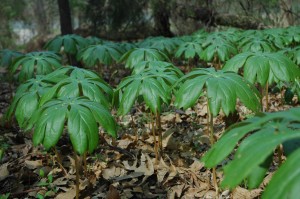Stanford scientists produce cancer drug from rare plant in lab to benefit human health.
Elizabeth Sattely, an assistant professor of chemical engineering at Stanford, and her graduate student Warren Lau have isolated the machinery for making a widely used cancer-fighting drug from an endangered plant.
Many of the drugs we take today to treat pain, fight cancer or other diseases were originally identified in plants, some of which are endangered or hard to grow. In many cases, those plants are still the primary source of the drug.Stanford scientists have produced a common cancer drug previously only available from an endangered plant in a common laboratory plant. This work could lead to a more stable supply of the drug and allow scientists to manipulate that drug to make it even safer and more effective
The drug Sattely chose to focus on is produced by a leafy Himalayan plant called the mayapple. Within the plant, a series of proteins work in a step-by-step fashion to churn out a chemical defense against predators.
Sattely and her team used a novel technique to identify proteins that work together in a molecular assembly line to produce the cancer drug. Her group then showed that the proteins could produce the compound outside the plant. . They put the machinery in a different plant, but they hope to eventually produce the drug in yeast.
Either the plant or yeast would provide a controlled laboratory environment for producing the drug. The starting material for this chemical defense is a harmless molecule commonly present in the leaf. When the plant senses an attack, it begins producing proteins that make up the assembly line.
Sattely and her team put various combinations of those proteins together until they eventually found 10 that made up the full assembly line. They put genes that make those 10 proteins into a common laboratory plant, and that plant began producing the chemical they were seeking. That chemical defense, after a few modifications in the lab, becomes a widely used cancer drug called etoposide.
This technique could potentially be applied to other plants and drugs, creating a less expensive and more stable source for those drugs. This work could lead to new ways of modifying the natural pathways to produce derivative drugs that are safer or more effective than the natural source.
For more information please visit:
http://news.stanford.edu


Comments are closed.